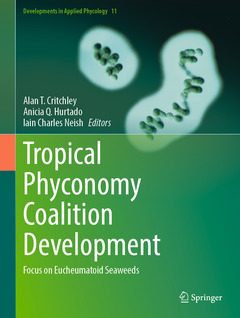Tropical Phyconomy Coalition Development, 1st ed. 2024 Focus on Eucheumatoid Seaweeds Developments in Applied Phycology Series, Vol. 11
Coordonnateurs : Critchley Alan T., Hurtado Anicia Q., Neish Iain Charles

Tropical seaweeds represent a major source of diversity and potential for cultivation. Cultivation of seaweeds has been coined ?phyconomy? (derived from phycology and agronomy). One of the world?s most important groups of tropical seaweeds is the eucheumatoids (comprising members of the genera Kappaphycus and Eucheuma). Whilst the biomass from these seaweeds is mostly used to produce colloids (i.e., various carrageenans) trends are changing and new, value-added applications are emerging including bioactives for agriculture, pharmaceutical applications, as well as bioplastics and possibly energy when processed as part of a MUZE (i.e., multi-stream, zero effluent), or biorefinery approach. Phyconomic activities around the production of seaweed biomass provides socio-economic benefits for many hundreds of thousands of global, coastal dwellers around a circum-tropical belt. However, times are changing and the once, repetitive manual aspects of attaching seaweed fragments to ropes and nets is beginning to be mechanized. Whilst it has taken agronomy several thousands of years to develop on land, its phyconomic counterpart is, at best, 50 years old in relation to developments in cultivation of eucheumatoids. Activities around cultivation of these tropical seaweeds can contribute to achieving the UN Sustainable Development Goals.
This book contains contributions from many of the world?s authorities on tropical seaweed farming with a focus on the eucheumatoids. There are many lessons learned and best-practice examples which will be of interest to students of phyconomy (phycology), marine science, industrial users of cultivated biomass, as well as practitioners in charge of coastal zone management and ensuring responsible and sustainable socio-economic benefits are derived from marine resources for coastal dwellers.
Dr. Alan T. Critchley is a Research Fellow, Verschuren Centre for Sustainability in Energy and Environment, Cape Breton, NS, Canada. Began his career in Portsmouth UK, graduated and moved into studies on the invasive seaweed Sargassum muticum. After a post-doc in the Netherlands he made his way to an academic post at Univ. KwaZulu Natal, Pietermaritzburg studying sub-tropical seaweeds off the east coast. Another move was made to the University Witwatersrand where his first interests in commercial seaweeds were ignited with Taurus Chemicals. After some time he moved to the Univ. Namibia, Windhoek to work in an academic and consultancy roles at the Multidisciplinary Research and Consultancy Centre. This then lead to a giant leap into the commercial world of (tropical) carrageenophytes and (temperate) alginophytes at Degussa Texturant Systems, Baupte, Normandie, France. More recently, he found his way to the Verschuren Centre via a small medium enterprise in Nova Scotia where he led the research group for onland cultivation of seaweeds for food and wild exploitation of an intertidal fucoid for animal feed and plant products. His current passion is phyconomy and particularly tropical seaweed phyconomy.
Dr Anicia Q. Hurtado is the Chair of the Integrated Services for the Development of Aquaculture and Fisheries (ISDA Inc.), an organization of past and present scientists of SEAFDEC-AQD. She finished her Doctor of Agriculture (Phycology) at Kyoto University, Kyoto, Japan in 1988 as a Monbusho scholar.
She worked closely with seaweed farmers as consultant of international funding agencies like WB-IFC, ADB, USAID, AusAID, GTZ, Cargill, ZSL, local agencies like PDAP, and government agency DA-BFAR in the pursuit of sustainable seaweed farming from lab-sea-based nurseries to field cultivation. She is the lead Editor of the Book – Tropical Seaweed Farming Trends, Problems and Opportunities: Focus on Spinosum and
Date de parution : 03-2024
Ouvrage de 321 p.
21x27.9 cm



